Clinical Reasoning Cycle for Identifying Health Complications
VerifiedAdded on 2022/11/16
|10
|1161
|88
Presentation
AI Summary
This presentation is based on a case study involving a 56-year-old male with complications of stroke, acute myocardial infarction, and hypertension. It discusses the pathophysiology of stroke, identifies the health risks, establishes SMART goals, and suggests pharmacological and non-pharmacological interventions.
Contribute Materials
Your contribution can guide someone’s learning journey. Share your
documents today.
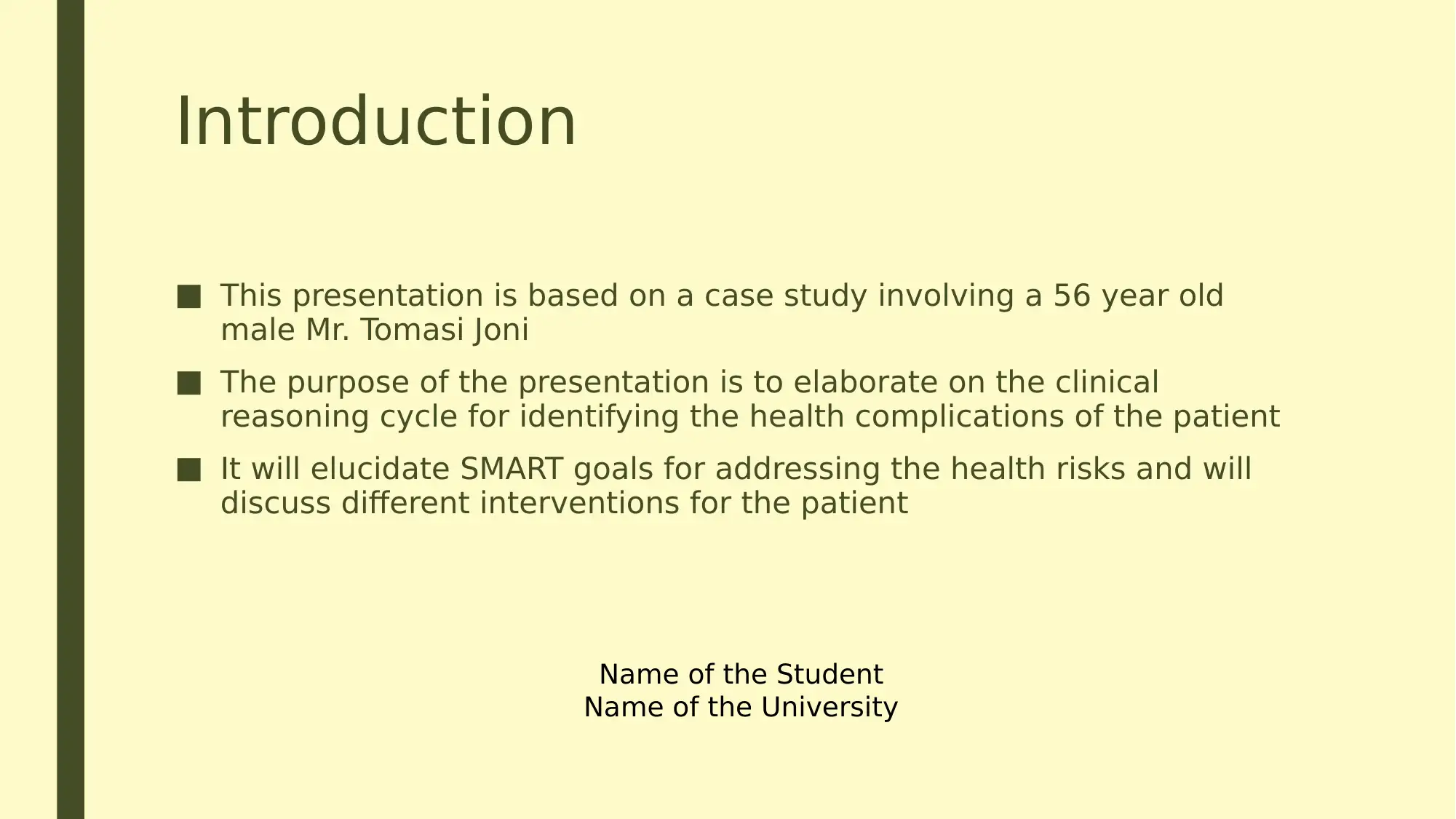
Introduction
■ This presentation is based on a case study involving a 56 year old
male Mr. Tomasi Joni
■ The purpose of the presentation is to elaborate on the clinical
reasoning cycle for identifying the health complications of the patient
■ It will elucidate SMART goals for addressing the health risks and will
discuss different interventions for the patient
Name of the Student
Name of the University
■ This presentation is based on a case study involving a 56 year old
male Mr. Tomasi Joni
■ The purpose of the presentation is to elaborate on the clinical
reasoning cycle for identifying the health complications of the patient
■ It will elucidate SMART goals for addressing the health risks and will
discuss different interventions for the patient
Name of the Student
Name of the University
Secure Best Marks with AI Grader
Need help grading? Try our AI Grader for instant feedback on your assignments.
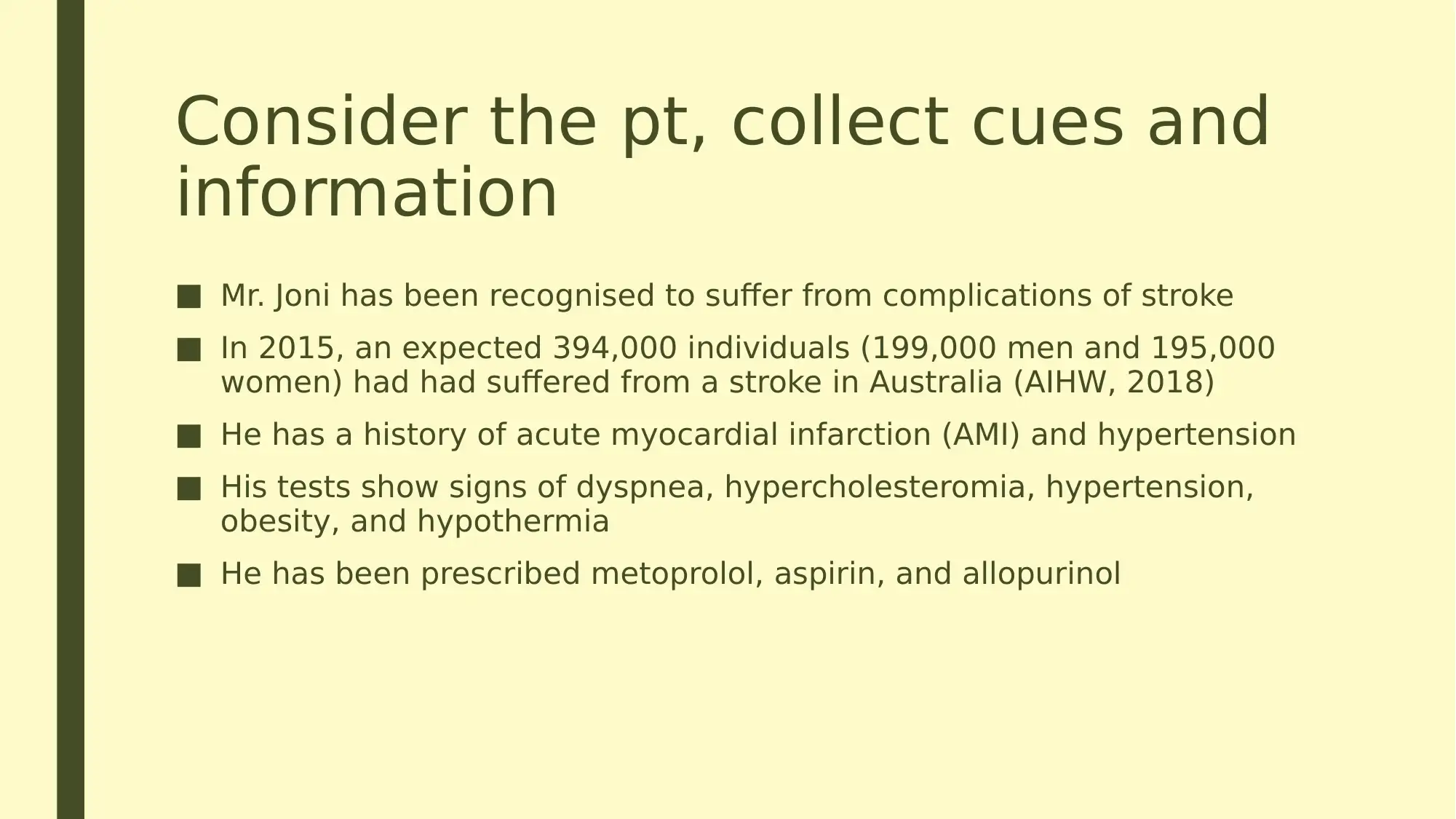
Consider the pt, collect cues and
information
■ Mr. Joni has been recognised to suffer from complications of stroke
■ In 2015, an expected 394,000 individuals (199,000 men and 195,000
women) had had suffered from a stroke in Australia (AIHW, 2018)
■ He has a history of acute myocardial infarction (AMI) and hypertension
■ His tests show signs of dyspnea, hypercholesteromia, hypertension,
obesity, and hypothermia
■ He has been prescribed metoprolol, aspirin, and allopurinol
information
■ Mr. Joni has been recognised to suffer from complications of stroke
■ In 2015, an expected 394,000 individuals (199,000 men and 195,000
women) had had suffered from a stroke in Australia (AIHW, 2018)
■ He has a history of acute myocardial infarction (AMI) and hypertension
■ His tests show signs of dyspnea, hypercholesteromia, hypertension,
obesity, and hypothermia
■ He has been prescribed metoprolol, aspirin, and allopurinol
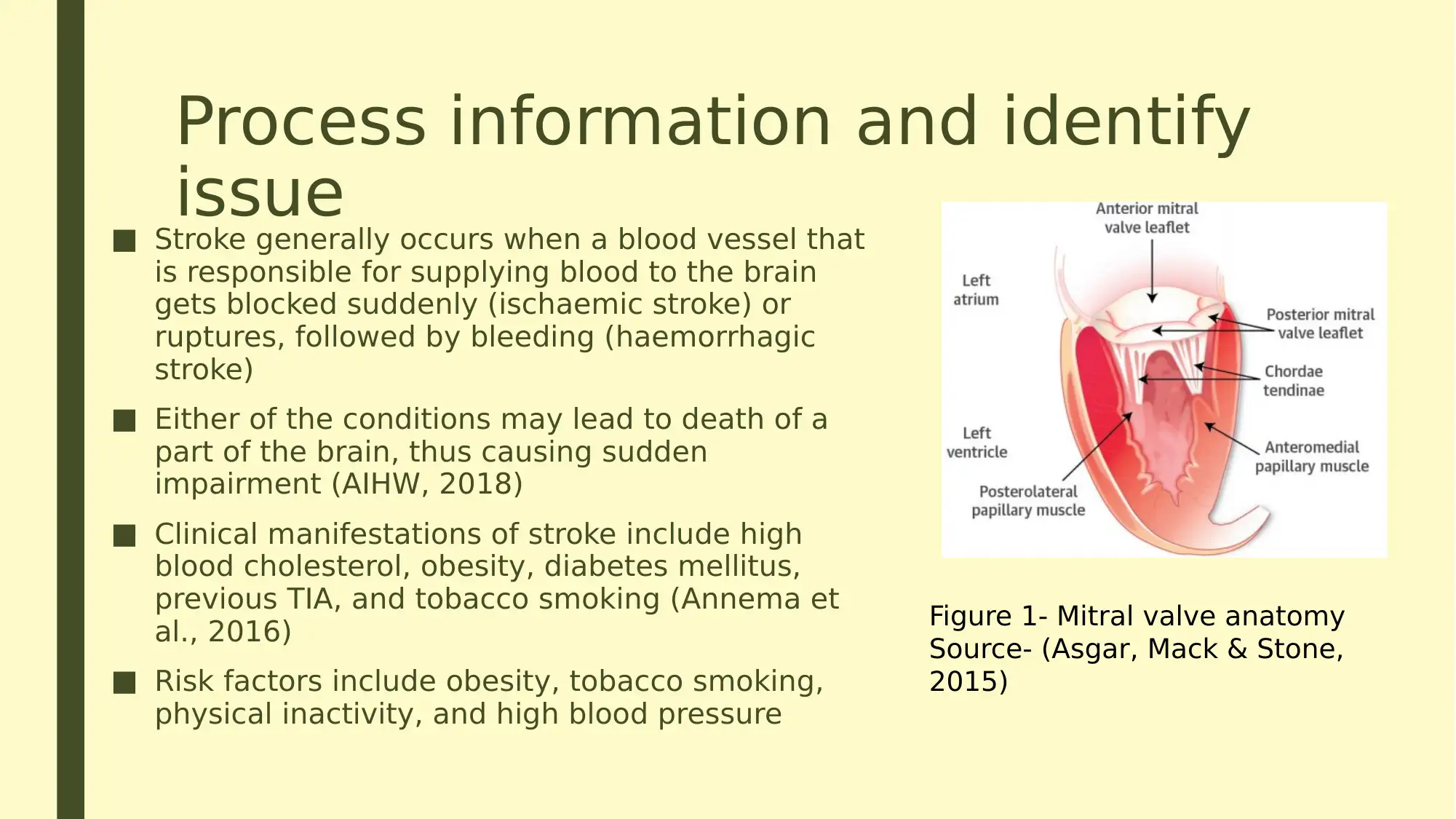
Process information and identify
issue■ Stroke generally occurs when a blood vessel that
is responsible for supplying blood to the brain
gets blocked suddenly (ischaemic stroke) or
ruptures, followed by bleeding (haemorrhagic
stroke)
■ Either of the conditions may lead to death of a
part of the brain, thus causing sudden
impairment (AIHW, 2018)
■ Clinical manifestations of stroke include high
blood cholesterol, obesity, diabetes mellitus,
previous TIA, and tobacco smoking (Annema et
al., 2016)
■ Risk factors include obesity, tobacco smoking,
physical inactivity, and high blood pressure
Figure 1- Mitral valve anatomy
Source- (Asgar, Mack & Stone,
2015)
issue■ Stroke generally occurs when a blood vessel that
is responsible for supplying blood to the brain
gets blocked suddenly (ischaemic stroke) or
ruptures, followed by bleeding (haemorrhagic
stroke)
■ Either of the conditions may lead to death of a
part of the brain, thus causing sudden
impairment (AIHW, 2018)
■ Clinical manifestations of stroke include high
blood cholesterol, obesity, diabetes mellitus,
previous TIA, and tobacco smoking (Annema et
al., 2016)
■ Risk factors include obesity, tobacco smoking,
physical inactivity, and high blood pressure
Figure 1- Mitral valve anatomy
Source- (Asgar, Mack & Stone,
2015)
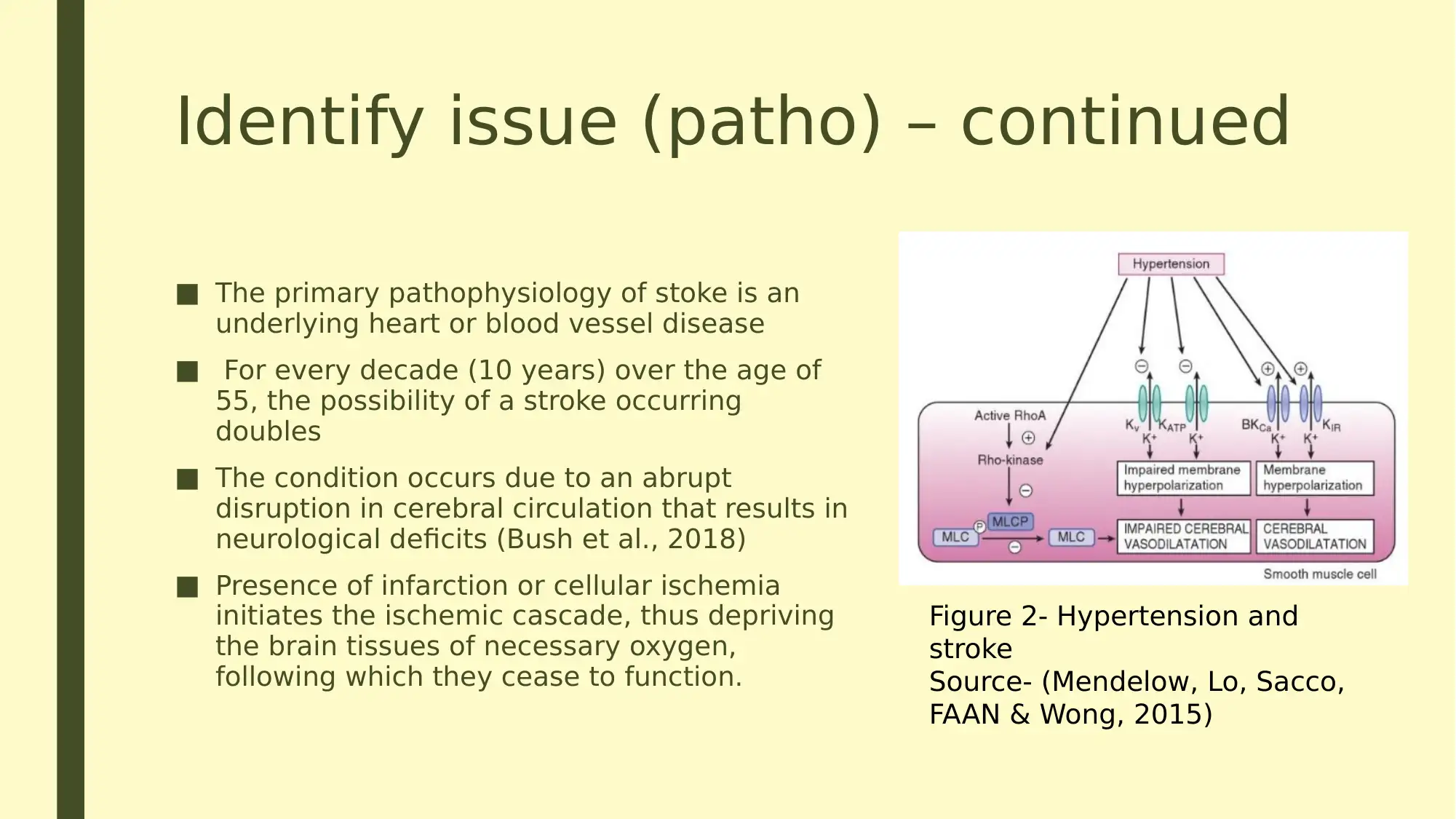
Identify issue (patho) – continued
■ The primary pathophysiology of stoke is an
underlying heart or blood vessel disease
■ For every decade (10 years) over the age of
55, the possibility of a stroke occurring
doubles
■ The condition occurs due to an abrupt
disruption in cerebral circulation that results in
neurological deficits (Bush et al., 2018)
■ Presence of infarction or cellular ischemia
initiates the ischemic cascade, thus depriving
the brain tissues of necessary oxygen,
following which they cease to function.
Figure 2- Hypertension and
stroke
Source- (Mendelow, Lo, Sacco,
FAAN & Wong, 2015)
■ The primary pathophysiology of stoke is an
underlying heart or blood vessel disease
■ For every decade (10 years) over the age of
55, the possibility of a stroke occurring
doubles
■ The condition occurs due to an abrupt
disruption in cerebral circulation that results in
neurological deficits (Bush et al., 2018)
■ Presence of infarction or cellular ischemia
initiates the ischemic cascade, thus depriving
the brain tissues of necessary oxygen,
following which they cease to function.
Figure 2- Hypertension and
stroke
Source- (Mendelow, Lo, Sacco,
FAAN & Wong, 2015)
Secure Best Marks with AI Grader
Need help grading? Try our AI Grader for instant feedback on your assignments.
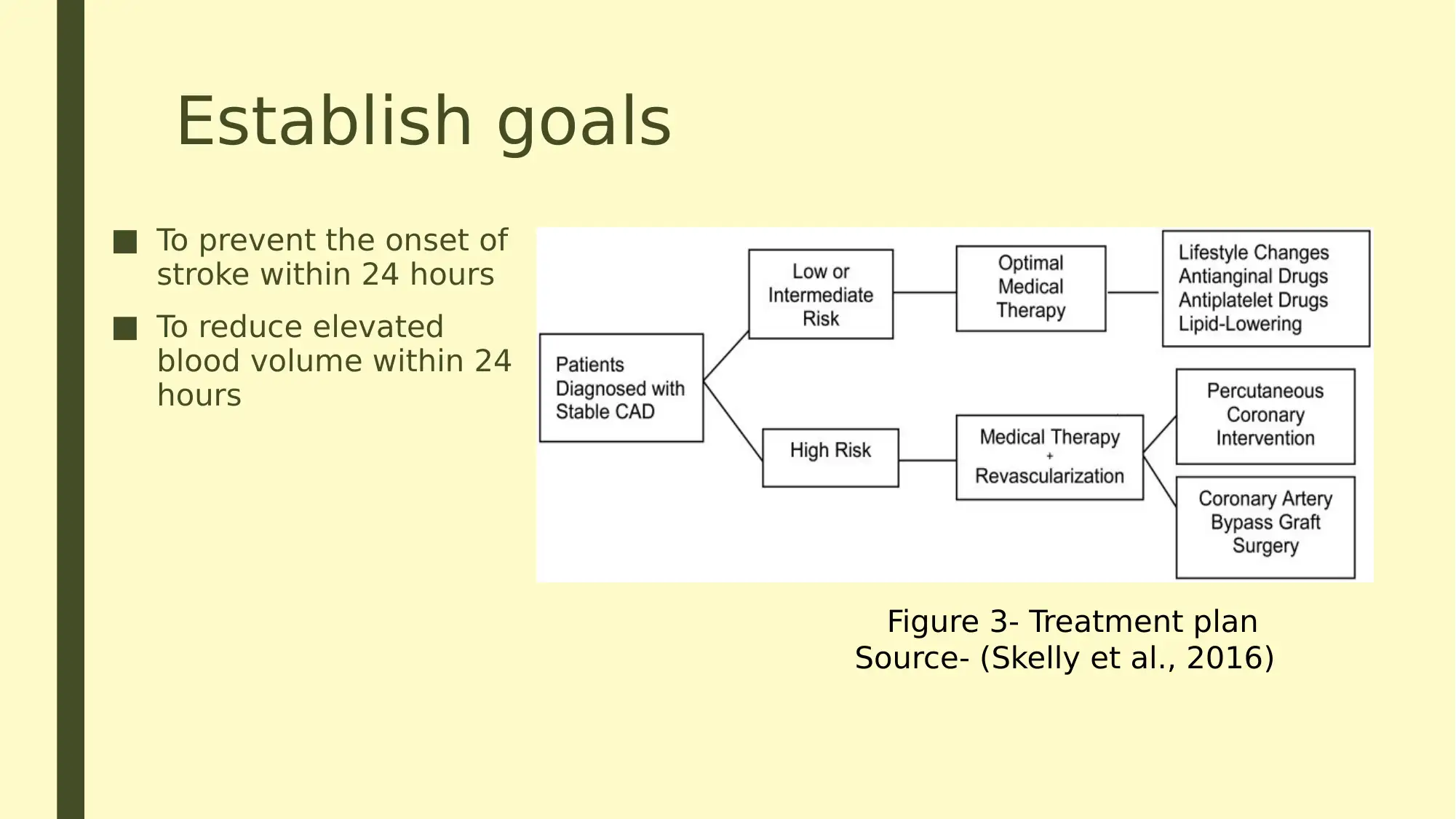
Establish goals
■ To prevent the onset of
stroke within 24 hours
■ To reduce elevated
blood volume within 24
hours
Figure 3- Treatment plan
Source- (Skelly et al., 2016)
■ To prevent the onset of
stroke within 24 hours
■ To reduce elevated
blood volume within 24
hours
Figure 3- Treatment plan
Source- (Skelly et al., 2016)
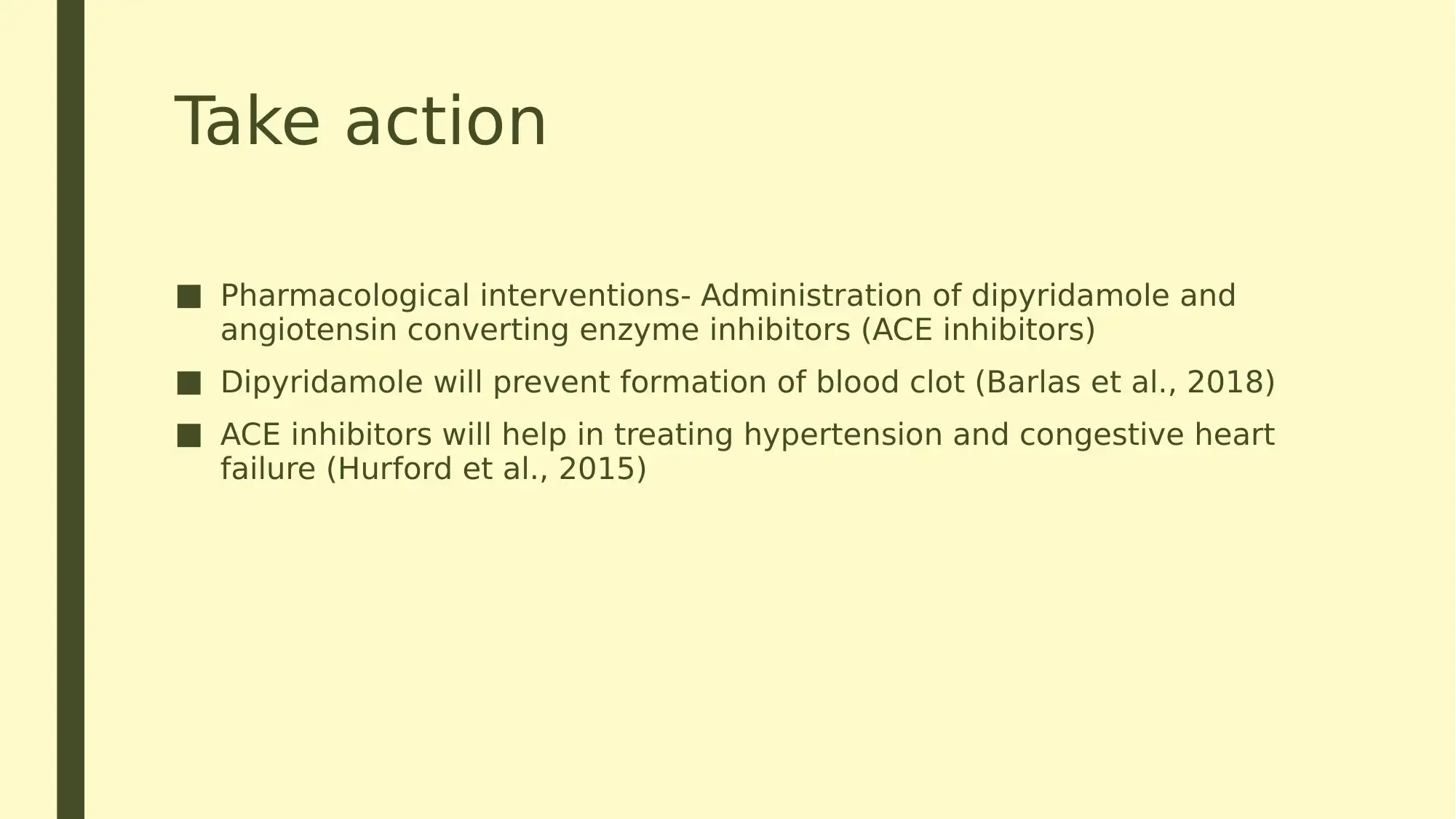
Take action
■ Pharmacological interventions- Administration of dipyridamole and
angiotensin converting enzyme inhibitors (ACE inhibitors)
■ Dipyridamole will prevent formation of blood clot (Barlas et al., 2018)
■ ACE inhibitors will help in treating hypertension and congestive heart
failure (Hurford et al., 2015)
■ Pharmacological interventions- Administration of dipyridamole and
angiotensin converting enzyme inhibitors (ACE inhibitors)
■ Dipyridamole will prevent formation of blood clot (Barlas et al., 2018)
■ ACE inhibitors will help in treating hypertension and congestive heart
failure (Hurford et al., 2015)
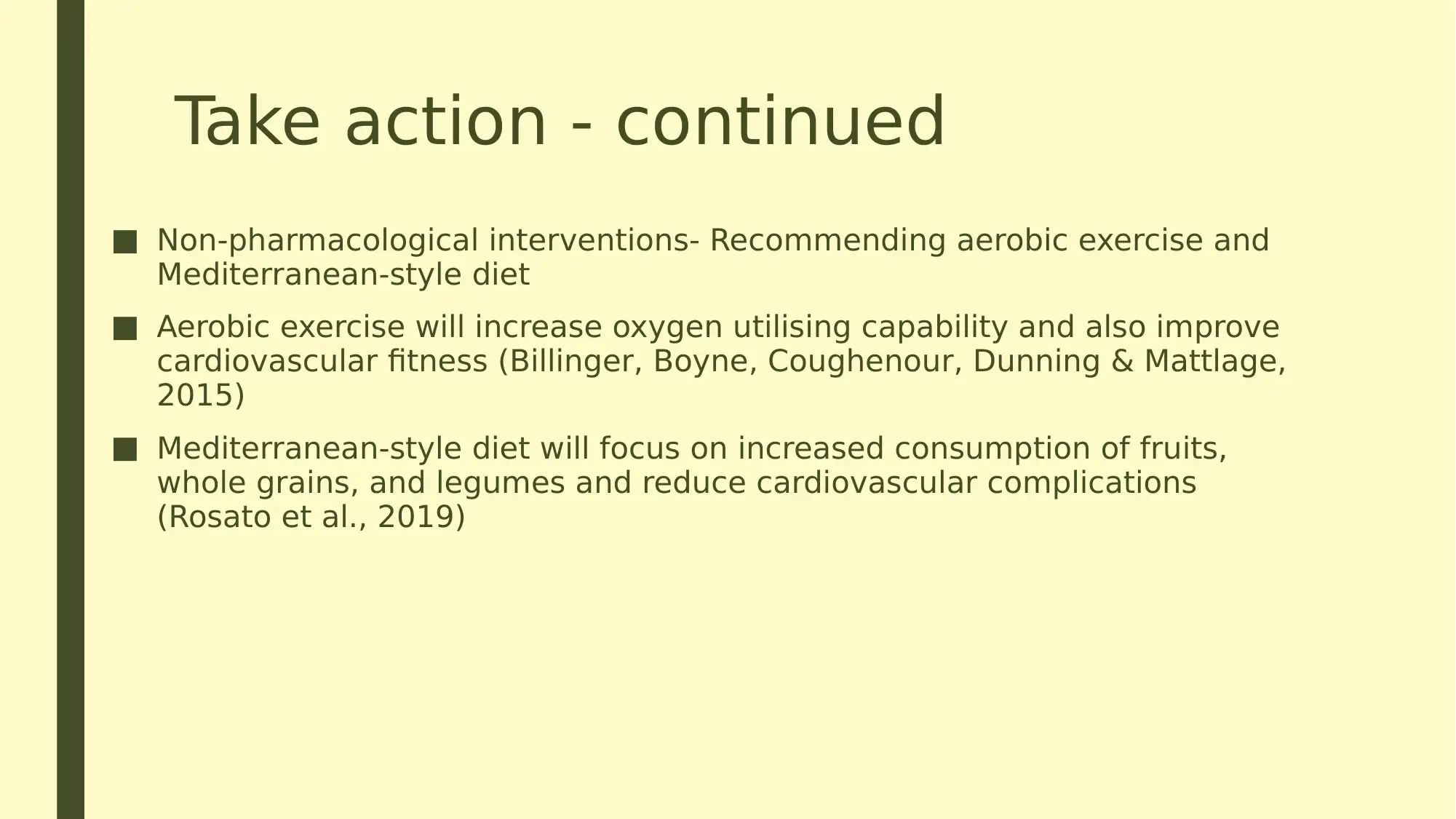
Take action - continued
■ Non-pharmacological interventions- Recommending aerobic exercise and
Mediterranean-style diet
■ Aerobic exercise will increase oxygen utilising capability and also improve
cardiovascular fitness (Billinger, Boyne, Coughenour, Dunning & Mattlage,
2015)
■ Mediterranean-style diet will focus on increased consumption of fruits,
whole grains, and legumes and reduce cardiovascular complications
(Rosato et al., 2019)
■ Non-pharmacological interventions- Recommending aerobic exercise and
Mediterranean-style diet
■ Aerobic exercise will increase oxygen utilising capability and also improve
cardiovascular fitness (Billinger, Boyne, Coughenour, Dunning & Mattlage,
2015)
■ Mediterranean-style diet will focus on increased consumption of fruits,
whole grains, and legumes and reduce cardiovascular complications
(Rosato et al., 2019)
Paraphrase This Document
Need a fresh take? Get an instant paraphrase of this document with our AI Paraphraser
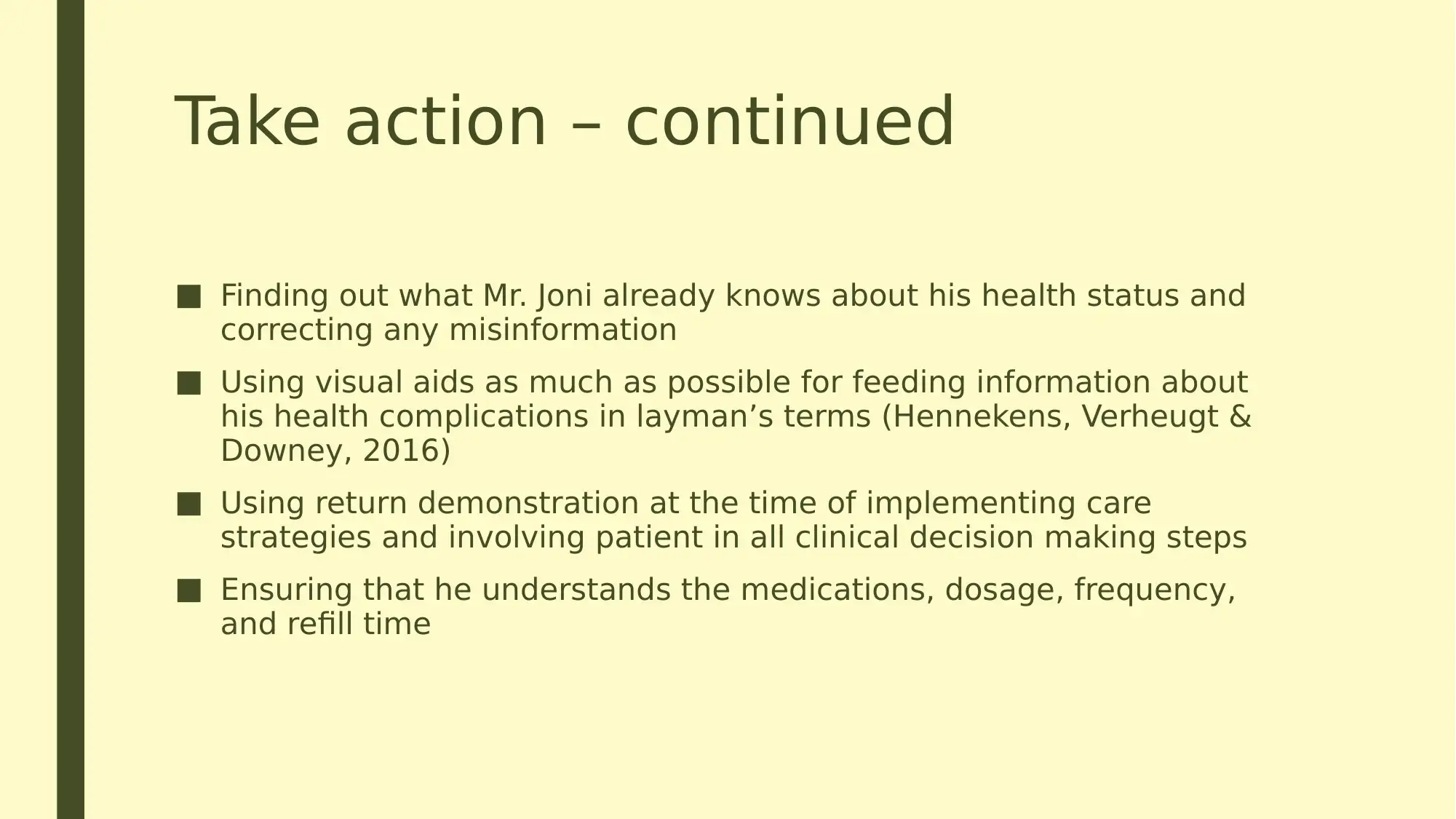
Take action – continued
■ Finding out what Mr. Joni already knows about his health status and
correcting any misinformation
■ Using visual aids as much as possible for feeding information about
his health complications in layman’s terms (Hennekens, Verheugt &
Downey, 2016)
■ Using return demonstration at the time of implementing care
strategies and involving patient in all clinical decision making steps
■ Ensuring that he understands the medications, dosage, frequency,
and refill time
■ Finding out what Mr. Joni already knows about his health status and
correcting any misinformation
■ Using visual aids as much as possible for feeding information about
his health complications in layman’s terms (Hennekens, Verheugt &
Downey, 2016)
■ Using return demonstration at the time of implementing care
strategies and involving patient in all clinical decision making steps
■ Ensuring that he understands the medications, dosage, frequency,
and refill time
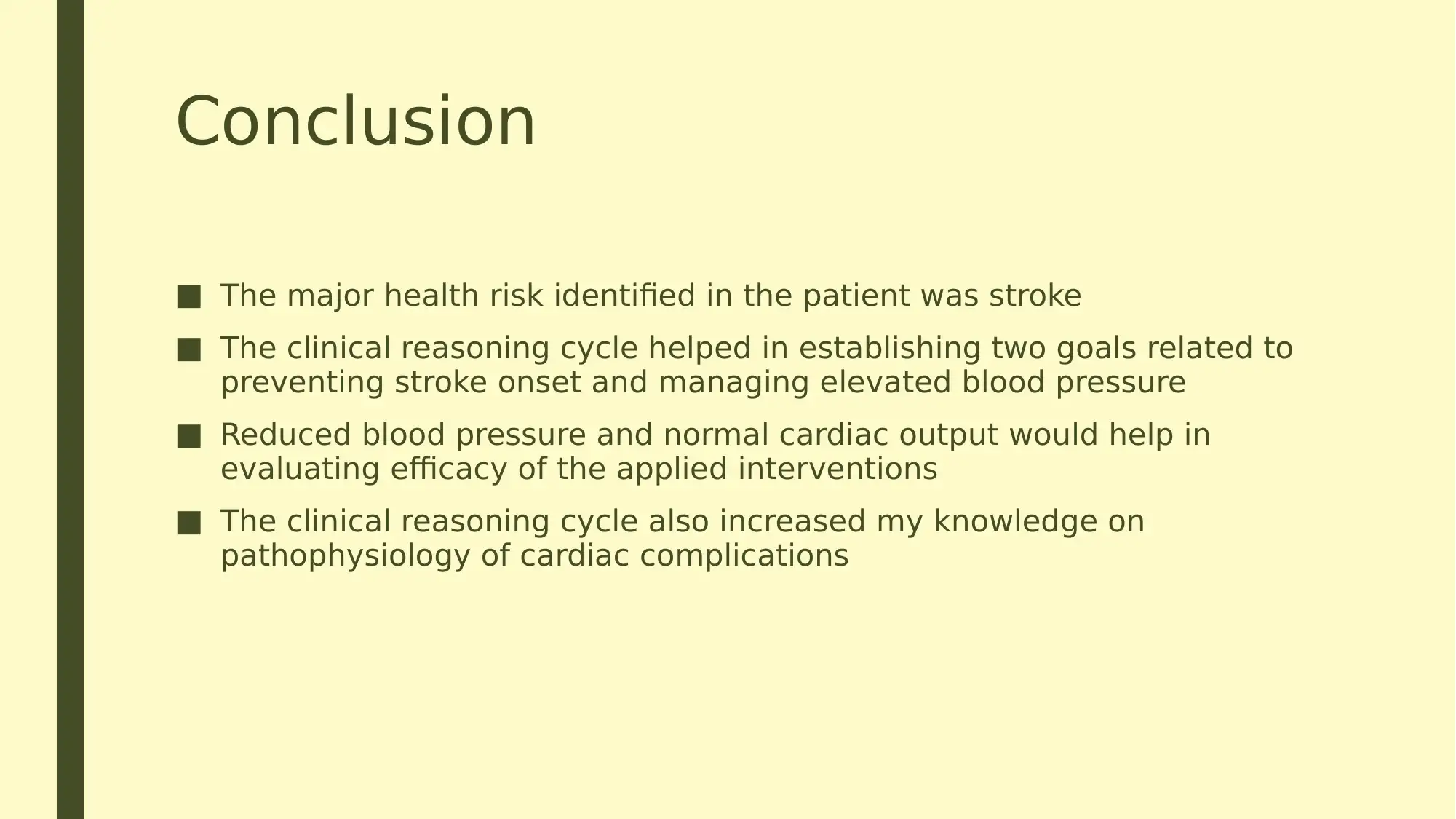
Conclusion
■ The major health risk identified in the patient was stroke
■ The clinical reasoning cycle helped in establishing two goals related to
preventing stroke onset and managing elevated blood pressure
■ Reduced blood pressure and normal cardiac output would help in
evaluating efficacy of the applied interventions
■ The clinical reasoning cycle also increased my knowledge on
pathophysiology of cardiac complications
■ The major health risk identified in the patient was stroke
■ The clinical reasoning cycle helped in establishing two goals related to
preventing stroke onset and managing elevated blood pressure
■ Reduced blood pressure and normal cardiac output would help in
evaluating efficacy of the applied interventions
■ The clinical reasoning cycle also increased my knowledge on
pathophysiology of cardiac complications
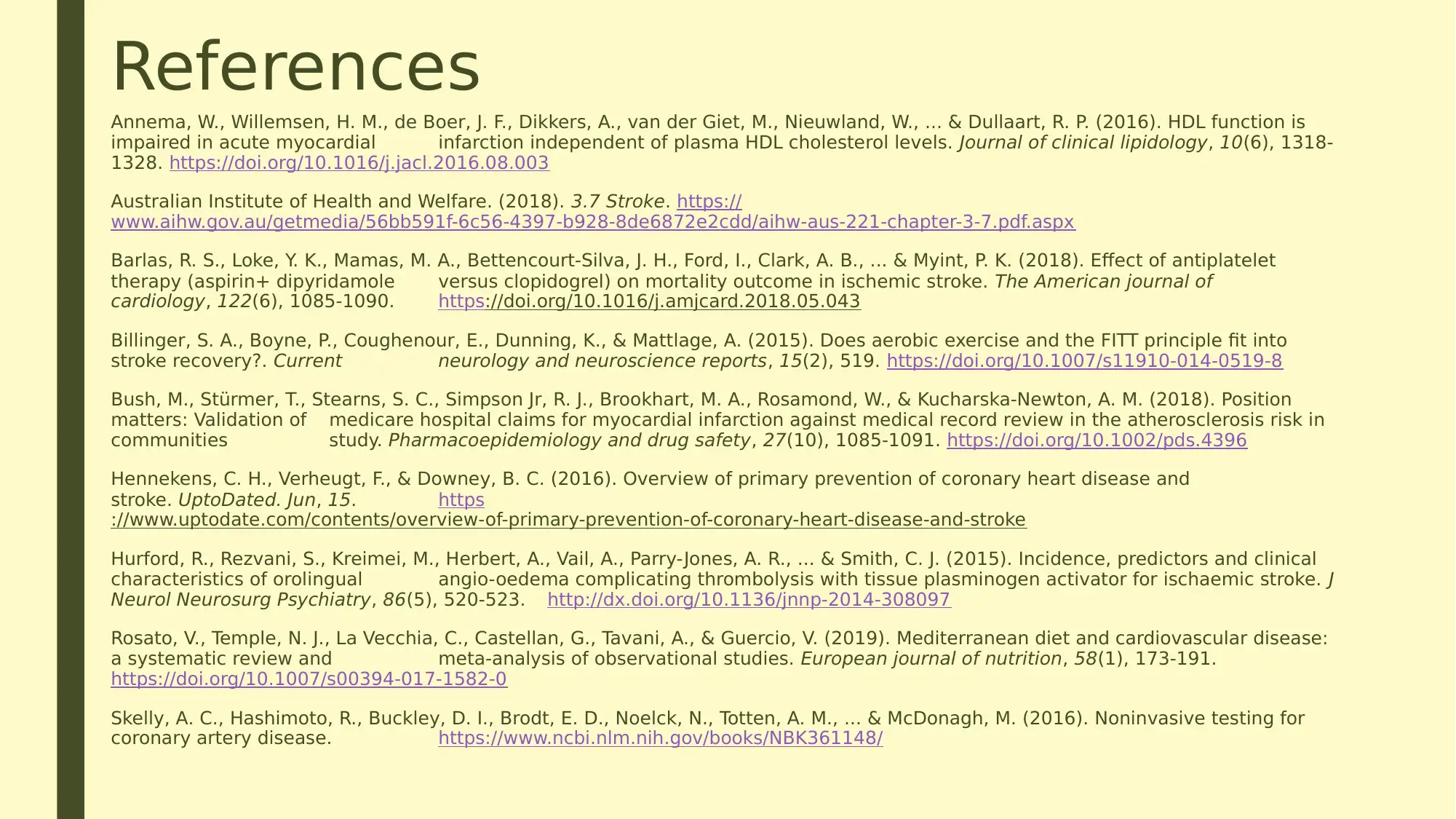
References
Annema, W., Willemsen, H. M., de Boer, J. F., Dikkers, A., van der Giet, M., Nieuwland, W., ... & Dullaart, R. P. (2016). HDL function is
impaired in acute myocardial infarction independent of plasma HDL cholesterol levels. Journal of clinical lipidology, 10(6), 1318-
1328. https://doi.org/10.1016/j.jacl.2016.08.003
Australian Institute of Health and Welfare. (2018). 3.7 Stroke. https://
www.aihw.gov.au/getmedia/56bb591f-6c56-4397-b928-8de6872e2cdd/aihw-aus-221-chapter-3-7.pdf.aspx
Barlas, R. S., Loke, Y. K., Mamas, M. A., Bettencourt-Silva, J. H., Ford, I., Clark, A. B., ... & Myint, P. K. (2018). Effect of antiplatelet
therapy (aspirin+ dipyridamole versus clopidogrel) on mortality outcome in ischemic stroke. The American journal of
cardiology, 122(6), 1085-1090. https://doi.org/10.1016/j.amjcard.2018.05.043
Billinger, S. A., Boyne, P., Coughenour, E., Dunning, K., & Mattlage, A. (2015). Does aerobic exercise and the FITT principle fit into
stroke recovery?. Current neurology and neuroscience reports, 15(2), 519. https://doi.org/10.1007/s11910-014-0519-8
Bush, M., Stürmer, T., Stearns, S. C., Simpson Jr, R. J., Brookhart, M. A., Rosamond, W., & Kucharska‐Newton, A. M. (2018). Position
matters: Validation of medicare hospital claims for myocardial infarction against medical record review in the atherosclerosis risk in
communities study. Pharmacoepidemiology and drug safety, 27(10), 1085-1091. https://doi.org/10.1002/pds.4396
Hennekens, C. H., Verheugt, F., & Downey, B. C. (2016). Overview of primary prevention of coronary heart disease and
stroke. UptoDated. Jun, 15. https
://www.uptodate.com/contents/overview-of-primary-prevention-of-coronary-heart-disease-and-stroke
Hurford, R., Rezvani, S., Kreimei, M., Herbert, A., Vail, A., Parry-Jones, A. R., ... & Smith, C. J. (2015). Incidence, predictors and clinical
characteristics of orolingual angio-oedema complicating thrombolysis with tissue plasminogen activator for ischaemic stroke. J
Neurol Neurosurg Psychiatry, 86(5), 520-523. http://dx.doi.org/10.1136/jnnp-2014-308097
Rosato, V., Temple, N. J., La Vecchia, C., Castellan, G., Tavani, A., & Guercio, V. (2019). Mediterranean diet and cardiovascular disease:
a systematic review and meta-analysis of observational studies. European journal of nutrition, 58(1), 173-191.
https://doi.org/10.1007/s00394-017-1582-0
Skelly, A. C., Hashimoto, R., Buckley, D. I., Brodt, E. D., Noelck, N., Totten, A. M., ... & McDonagh, M. (2016). Noninvasive testing for
coronary artery disease. https://www.ncbi.nlm.nih.gov/books/NBK361148/
Annema, W., Willemsen, H. M., de Boer, J. F., Dikkers, A., van der Giet, M., Nieuwland, W., ... & Dullaart, R. P. (2016). HDL function is
impaired in acute myocardial infarction independent of plasma HDL cholesterol levels. Journal of clinical lipidology, 10(6), 1318-
1328. https://doi.org/10.1016/j.jacl.2016.08.003
Australian Institute of Health and Welfare. (2018). 3.7 Stroke. https://
www.aihw.gov.au/getmedia/56bb591f-6c56-4397-b928-8de6872e2cdd/aihw-aus-221-chapter-3-7.pdf.aspx
Barlas, R. S., Loke, Y. K., Mamas, M. A., Bettencourt-Silva, J. H., Ford, I., Clark, A. B., ... & Myint, P. K. (2018). Effect of antiplatelet
therapy (aspirin+ dipyridamole versus clopidogrel) on mortality outcome in ischemic stroke. The American journal of
cardiology, 122(6), 1085-1090. https://doi.org/10.1016/j.amjcard.2018.05.043
Billinger, S. A., Boyne, P., Coughenour, E., Dunning, K., & Mattlage, A. (2015). Does aerobic exercise and the FITT principle fit into
stroke recovery?. Current neurology and neuroscience reports, 15(2), 519. https://doi.org/10.1007/s11910-014-0519-8
Bush, M., Stürmer, T., Stearns, S. C., Simpson Jr, R. J., Brookhart, M. A., Rosamond, W., & Kucharska‐Newton, A. M. (2018). Position
matters: Validation of medicare hospital claims for myocardial infarction against medical record review in the atherosclerosis risk in
communities study. Pharmacoepidemiology and drug safety, 27(10), 1085-1091. https://doi.org/10.1002/pds.4396
Hennekens, C. H., Verheugt, F., & Downey, B. C. (2016). Overview of primary prevention of coronary heart disease and
stroke. UptoDated. Jun, 15. https
://www.uptodate.com/contents/overview-of-primary-prevention-of-coronary-heart-disease-and-stroke
Hurford, R., Rezvani, S., Kreimei, M., Herbert, A., Vail, A., Parry-Jones, A. R., ... & Smith, C. J. (2015). Incidence, predictors and clinical
characteristics of orolingual angio-oedema complicating thrombolysis with tissue plasminogen activator for ischaemic stroke. J
Neurol Neurosurg Psychiatry, 86(5), 520-523. http://dx.doi.org/10.1136/jnnp-2014-308097
Rosato, V., Temple, N. J., La Vecchia, C., Castellan, G., Tavani, A., & Guercio, V. (2019). Mediterranean diet and cardiovascular disease:
a systematic review and meta-analysis of observational studies. European journal of nutrition, 58(1), 173-191.
https://doi.org/10.1007/s00394-017-1582-0
Skelly, A. C., Hashimoto, R., Buckley, D. I., Brodt, E. D., Noelck, N., Totten, A. M., ... & McDonagh, M. (2016). Noninvasive testing for
coronary artery disease. https://www.ncbi.nlm.nih.gov/books/NBK361148/
1 out of 10
Related Documents
Your All-in-One AI-Powered Toolkit for Academic Success.
+13062052269
info@desklib.com
Available 24*7 on WhatsApp / Email
![[object Object]](/_next/static/media/star-bottom.7253800d.svg)
Unlock your academic potential
© 2024 | Zucol Services PVT LTD | All rights reserved.





